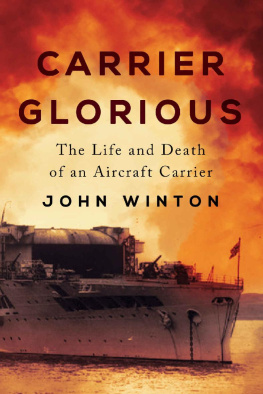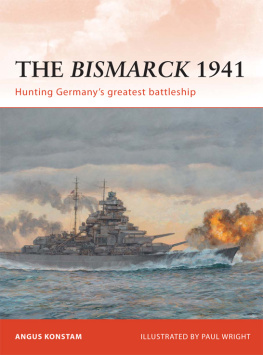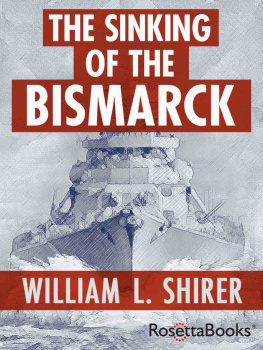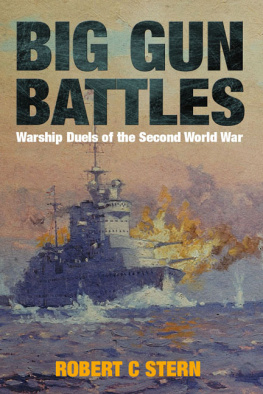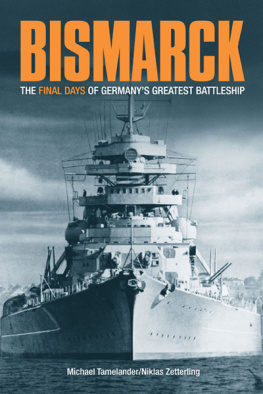John Moffat was nineteen years old when he joined the ArkRoyal and is the only surviving member of the group of fifteenpilots who sank the Bismarck. John continued to fly until veryrecently, and now lives in Scotland, but frequently gives talksat airshows and events around the UK.
www.rbooks.co.uk
I SANK THE BISMARCK
www.rbooks.co.uk
This eBook is copyright material and must not be copied, reproduced, transferred, distributed, leased, licensed or publicly performed or used in any way except as specifically permitted in writing by the publishers, as allowed under the terms and conditions under which it was purchased or as strictly permitted by applicable copyright law. Any unauthorised distribution or use of this text may be a direct infringement of the author's and publisher's rights and those responsible may be liable in law accordingly.
ISBN 9781409082194
Version 1.0
www.randomhouse.co.uk
TRANSWORLD PUBLISHERS
6163 Uxbridge Road, London W5 5SA
A Random House Group Company
www.rbooks.co.uk
First published in Great Britain
in 2009 by Bantam Press
an imprint of Transworld Publishers
Copyright John Moffat with Mike Rossiter 2009
John Moffat and Mike Rossiter have asserted their rights under the Copyright,
Designs and Patents Act 1988 to be identified as the authors of this work.
A CIP catalogue record for this book
is available from the British Library.
This electronic book is sold subject to the condition that it shall not by way of trade or otherwise, be lent, resold, hired out, or otherwise circulated without the publisher's prior consent in any form other than that in which it is published and without a similar condition including this condition being imposed on the subsequent purchaser
Addresses for Random House Group Ltd companies outside the UK
can be found at: www.randomhouse.co.uk
The Random House Group Ltd Reg. No. 954009
ISBN: 9781409082194
Version 1.0
2 4 6 8 10 9 7 5 3 1
John Moffat would like to dedicate this book to the memoryof his lovely wife Marjorie, who shared his life for 58 years;their two daughters Pat and Jan, who encouraged him towrite about his life; and his four grandchildren, Nicole,Amanda, Ian and Valerie.
Mike Rossiter would like to thank the Headmaster of KelsoHigh School, and the former crew members of HMS ArkRoyal for their help in researching this book. Also the assistanceof his agent Luigi Bonomi, editor Simon Thorogood, andcopy-editor Brenda Updegraff are gratefully acknowledged.
Introduction
I slid the canopy of my Grumman single-engined aeroplaneshut and tightened my safety harness, then pushed the yokeforward so that I could turn to the passenger seat to see if Ianneeded any help to strap himself in properly. He was a smartlad, but he was just nine years old. I wanted to make sure hewas safe.
'Are you OK, lad?' I asked him.
'Yes, Grandad, I'm fine.'
It was a lovely September evening in the year 2000. I waseighty-one years old and had brought up two daughters, butnow I had a grandson, and I loved him. It was funny how lifeturned out. He had just started playing rugby at school and Ihad given him a few tips that his mother thought were moresuited to the adult game than to a prep-school team, but hewas coming on a treat.
I looked through the windscreen: some slight cloud cover,with a south-westerly wind of about 5 knots. We were on asmall grass airfield on the Isle of Bute, with a runway lengthof 1,300 feet. We were about 1,730lb in weight and should beable to take off in about 800 feet, giving us plenty of room.
I made sure the handbrake was on, then pressed the startermotor. The Lycoming engine turned over, once, twice, threetimes, then it fired up. The twin-bladed propeller became ablur in front of the engine cowling and I waited for thetemperature and the oil pressure to stabilize. Everythinglooked fine. I released the handbrake, eased a touch on thethrottle, and the plane moved forward, trundling over thegrass to the end of the strip.
I was going to make what is called a performance take-off,which I think is the safest option. You hold the plane on thebrakes until the engine is running at full power, then yourelease the brakes and take off in half the recommendeddistance. Grumman's handbook for the AA-5 suggests takingoff with no flap the sections at the rear of the wing that, ifmoved down, provide more lift but you can get a higher rateof climb with 10 degrees of flap and so I selected this with theflap lever, then with the handbrake on again increased the revsto full power. The orange windsock hung loosely, barelyextended in the light breeze. Everything was clear above andbehind. I patted Ian on the knee and released the handbrake.We were lightly loaded, and the air-speed indicator quicklystarted rising.
We had rolled for about half our take-off distance when theengine started misfiring. The r.p.m. needle was bouncing upand down, and there were more misfires. We were travellingmore slowly than we needed to be at this stage of the take-off,but we still had some distance left on the runway. I could keepgoing and hope that the engine would give us enough powerto take off, but then I could be faced with having to crashstraight ahead if it cut while we were struggling for height. Iquickly decided that I was not going to risk it.
'Oh Christ, this would happen,' I thought. I cut the engineand tried to put on the brakes, but we were still moving atclose to our lift-off speed. There was a hump in the grass stripat the end of the runway: we hit it, bounced up from it androse into the air. Then we dropped again as the undercarriagehit the hedge.
'Hang on!' I shouted and put out my arm to protect Ian.Then, as clods of earth and grass hit the windows, we bangedand scraped along, and finally smashed into a deep ditch.
The silence as we came to a halt was eerie. I was desperateto get Ian out in case we caught fire. The poor lad was sittingthere, trying to gather himself together, and I undid hisstraps. The canopy still opened, thank God, so I slid it backand told him to get out and run to the edge of the field. Oncehe had gone, I slowly undid my own straps and climbed out.I couldn't move as fast as I would have liked, and I had beenshaken about by the impact. Ian was looking at me anxiously,so I walked over to him and said as reassuringly as I could,'Not to worry, son we're fine.'
I didn't feel fine. I was shaken up and I knew that actuallywe were lucky not to have been hurt. The plane, which I coowned,was damaged how badly I didn't know at the time,and probably wouldn't until an engineer had had a good lookat it. It might be a write-off. I didn't yet know why the enginehad failed. As far as I was aware, there was no water in eitherthe tank or the lines. There were bound to be gentle hints thatmaybe a man of my age should hang up his flying helmet, andsimilar talk.
All this was going through my mind but, thank God, Ianwas safe.
A couple of men came running from the airstrip, one ofthem carrying a fire extinguisher, and told me that they hadcalled the Royal Naval Air Station (RNAS) rescue helicopterfrom the mainland and it should be here in a few minutes. Itwas too late to protest that we were really not hurt at all.
Sure enough, ten minutes later a Sea King helicopterswooped over us, its turbines whining and its rotors clattering.This would be a flight that Ian hadn't bargained for, andI hoped it would be exciting enough to lessen the shock of ourcrash. The young winchman got out, looked us over, and saidthat he would take us to hospital for a check-up as aprecaution. He lifted Ian in, then helped me up the steps intothe cabin.
We lifted off, the young man sitting opposite us in hispolished black flying boots and green flight overalls, awhippersnapper probably still in his twenties. While he talkedto the pilot over his intercom, he was also looking at meslightly quizzically. I imagined he was probably thinking,'What's an old crock like this doing trying to fly?' but then hesaid, 'I think you and I have met before, sir.'



